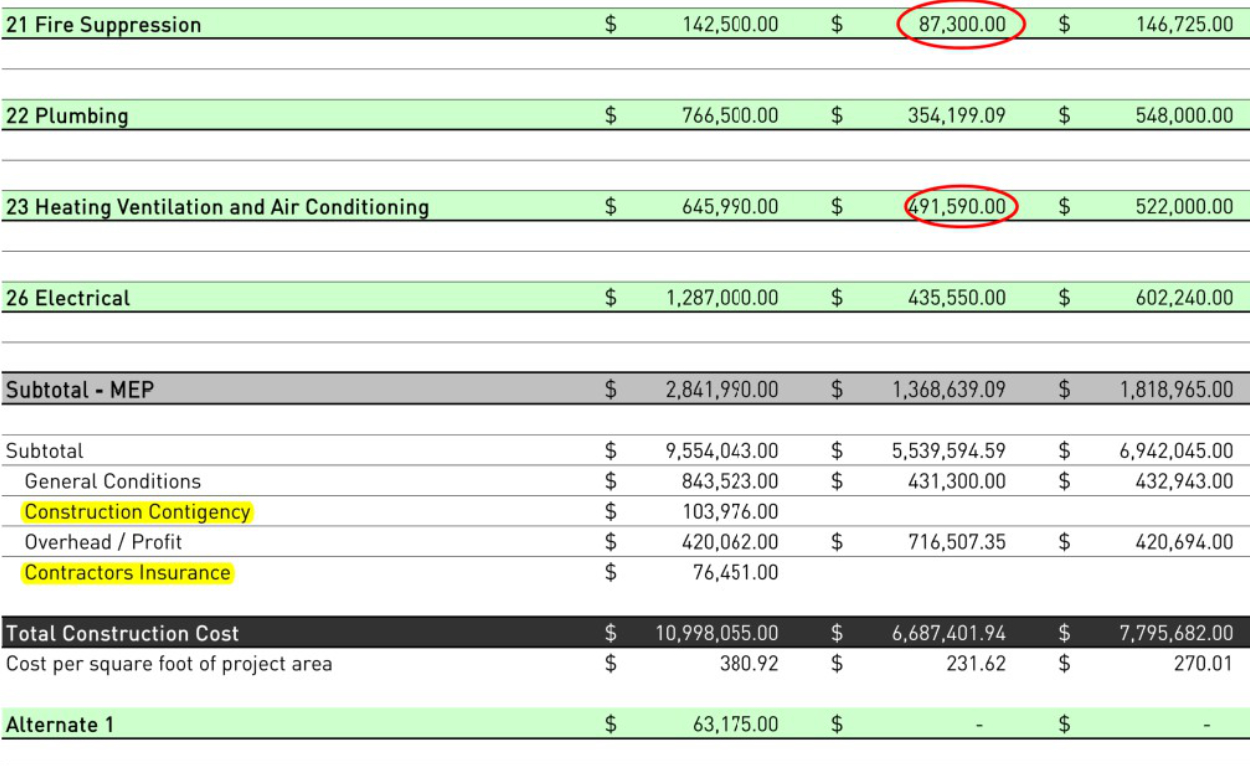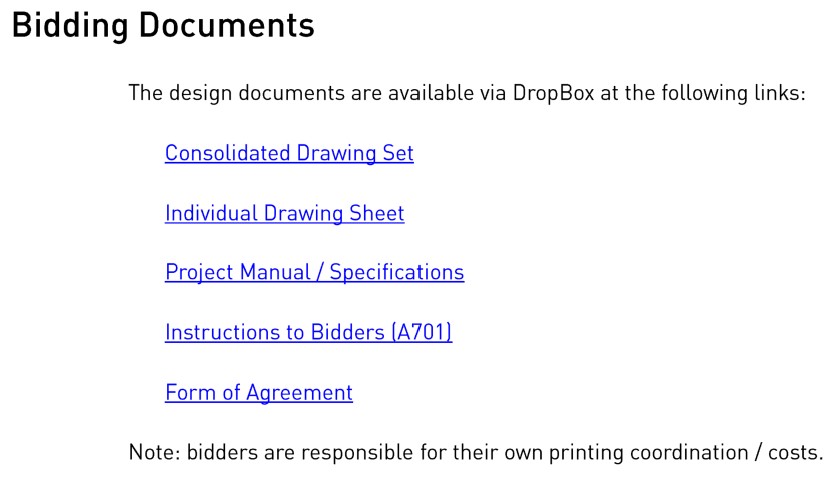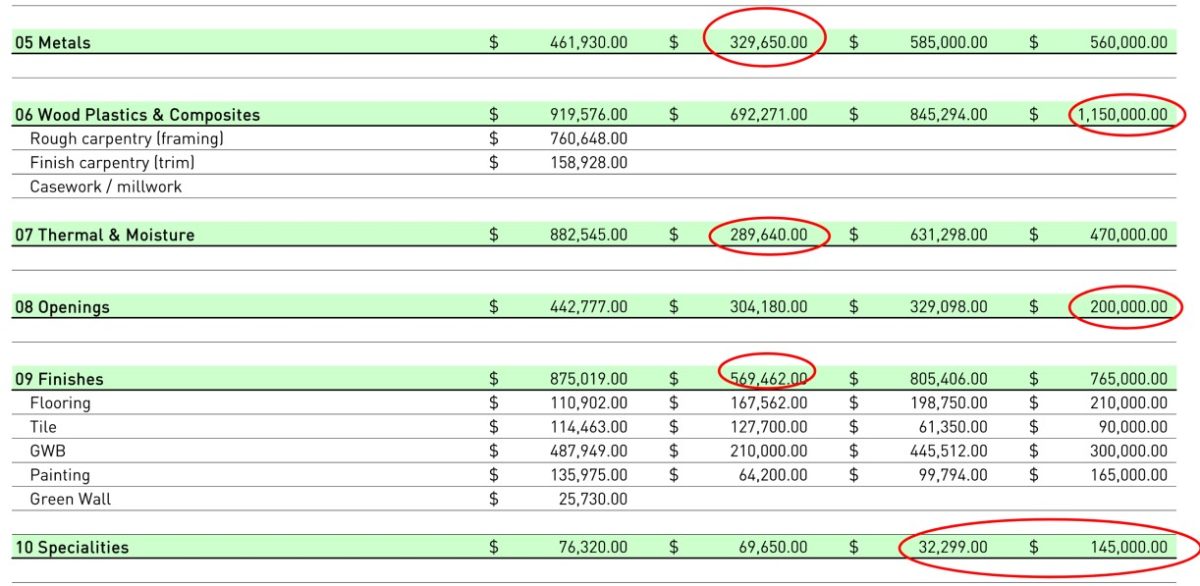The Critical Role of Bidding and Negotiation

The bidding and negotiation phase is a crucial transition in any construction project. It sets the foundation for selecting the right contractor, establishing clear expectations, and mitigating risks that could impact the project’s success. Architects play an essential role in guiding owners through this process. In this article, we explore the importance of the bidding and negotiation phase, discuss best practices, and highlight some red (or yellow) flags to watch out for when selecting a contractor.
The Value of the Architect in the Bidding and Negotiation Phase
During the bidding and negotiation phase, architects provide invaluable support to owners in several ways:
-
- Contractor Selection: We help identify suitable general contractors based on experience, reliability, and project fit.
- Contract Structuring: We assist in reviewing and suggesting the appropriate form of contract with terms that protect the owner’s interests and ensure fair agreements between the parties.
- Request for Proposal or Pricing (RFP) Development: We create comprehensive RFP documents that outline project requirements, expectations, and standards.
- Bid Qualification and Analysis: We examine bids for discrepancies, put together a bid comparison documents so we can evaluate bids in an “apples to apples” way, review allowances, qualifications or exclusions, and we work to ensure fairness in the bidding process.
- Pre-Bid Support: We answer contractors’ questions (sometimes referred to as “RFI’s or Pre-Bid Questions” – as well as clarify expectations to prevent misunderstandings and lessen the opportunities for change orders during the construction process.
Open Bidding vs. Negotiated Contracts
Construction projects can follow different bidding approaches the two we most often see are:
Negotiated Contracts: In this method, the owner works closely with a pre-selected contractor to develop the project budget. Often, the contractor will work under a letter of intent and are often paid a fee for their time in putting together the pricing. This fee is typically credited toward the project if it proceeds. The fee is surrendered if the project does not.
Open / Invited Bidding: Here, multiple contractors submit bids based on the RFP documents provided. The owner then selects a contractor, not necessarily based on the lowest bid but rather on the best overall proposal. We will often assist the owner in selecting a pool of contractors that we think are good fit for the project and invite them to bid.
While negotiated contracts allow for early collaboration and alignment of expectations, open bidding provides competitive pricing but may take longer to arrive at a final decision. In our experience, one or more contractors may pull out of the bidding process, and it will leave us with less competitive numbers to evaluate or one number that is very high and one that is very low. It doesn’t happen often, but sometimes this means we need to re-bid the project. Aiming for three to five qualified bidders is recommended. The ideal number depends on project complexity and market conditions. In our experience, the negotiated contract tends to be more associated with single-family residential projects.
How does the Bidding and Negotiation Process Work?
In an Open Bid process, initially we pull together a potential list of general contractors that we think are a good fit for the project. Then we assemble the Request for Proposal (RFP) documents which would include an Invitation to Bid (this often includes instruction to bidders, but this can also be in a separate document like the AIA A701), construction drawings, specifications or project manual, and we will often include the proposed Form of Agreement (like the AIA A105, or A101). In our office we also include a Bid Form that allows us to review all the bids in a similar format. This makes it easier for us to review and qualify the bids. The Invitation to Bid also includes the due date and if there are any bonding or special insurance requirements for the project.

Bidding and Negotiation – RFP Documents
A site visit is important during this process. This allows the contractor to gain an understanding of any site specific challenges, such as where to stockpile material, any access logistics required, and neighborhood interactions or sensitivities. This allows for more informed pricing estimates that include information that is difficult to capture in drawings and bid documents. The question of whether to have multiple contractors do the initial site visits simultaneously or conduct separate walkthroughs is something the comes up often. One advantage is less disruption for the owner and less administrative work for the architect. The disadvantage is that most contractors know who their competitors are and may end up skewing their numbers if they know who else is bidding on the project. This may result in less competitive bids. Usually, we see the multiple contractor walk-through on commercial or institutional projects where the bidding process is more formalized.
We have found more recently that we get requests from the General Contractor to extend the timeline due to delays in assembling bids from subcontractors. If there is not a financial impact to the project we will usually grant it. Once the bids are returned, we begin our evaluation process which we refer to as “qualifying” the bid. We use a bid comparison spreadsheet that allows for a line-by-line analysis based on the CSI Divisions. This allows us to isolate any large anomalies based on a discipline or specific trade. We will also review any exclusions, proposed revisions to the contract, allowances or alternates, and proposed project schedule.

Bidding and Negotiation – Bid Comparison
We then usually go through a round of interviews and follow-ups with the general contractors. In our work we typically are not required to go with the lowest bid, we are free to select the general contractor that brings the best overall value to the project.
Typically, we have found that this process takes around six to eight weeks, though it may be extended due to revisions or additional scope added to the project or if the project is particularly complex.
The Role of Personal Relationships During Construction
Beyond numbers and contracts, the construction process is heavily influenced by personal relationships. In single-family home projects, in particular, the chemistry between the owner and contractor is vital to ensure smooth communication and collaboration. You are entering into a long-term (usually multiple year) relationship and it’s important to have a good report with everyone involved. Especially at the beginning of the project. To put it bluntly, you want to work with people you like and are collaborators with a common goal. Face-to-face interactions provide valuable insights into the contractor’s working style, transparency, and reliability.
Selecting the right contractor is one of the most critical decisions in a construction project. The wrong choice can lead to financial losses, delays, and strained relationships. Owners should conduct independent reference checks, rather than relying solely on the contractor’s provided references.
Additionally, having at least two or three viable contractor options ensures flexibility if negotiations with the first-choice contractor do not work out.
Yellow Flags: Things to Watch for During Bidding and Negotiation
When dealing with general contractors, certain warning signs warrant closer examination:
-
- Excessive exclusions or contract revisions: This could indicate hidden costs or an attempt to limit responsibilities.
- Unclear allowances for materials or products: Undefined costs for finishes and materials can lead to unexpected expenses.
- Owner-provided materials or labor: While this can be an effort at cost-saving, this approach may cause quality control issues, schedule conflicts, and responsibility disputes.
- Inadequate insurance coverage: Contractors should carry proper insurance to protect against liabilities.
- Insistence on contractor-drafted agreements: These often favor the contractor and may lack key owner protections.
- Numerous alterations to standard contracts: This may indicate an attempt to manipulate terms in the contractor’s favor.
- Overly aggressive payment terms: Most contracts are structured with monthly payments corresponding to work completed. There is also usually some level of retainage (money you hold back until the end of the project) to protect the owner and incentivize the contractor to finish. If the contractor wants different terms, then it’s important to understand why.

Bidding and Negotiation – Contractor Exclusions
While these factors do not automatically disqualify a contractor, they should prompt a deeper investigation before proceeding.
Final Thoughts: A Strategic Approach to Bidding and Negotiation
The Bidding and Negotiation phase is a pivotal moment that shapes the entire construction process. Ensuring a thorough evaluation of contractors, structuring fair contracts, and being vigilant for yellow flags can significantly reduce project risks. As part of ongoing efforts to improve the process, we will often interview past clients about their experiences during this phase. Their insights help provide real-world perspectives on what works, what doesn’t, and how to navigate the complexities of contractor selection effectively. By taking a proactive and strategic approach, owners can secure the right team for their projects, ensuring successful and less stressful construction experiences. Next up the Construction Administration Phase.
